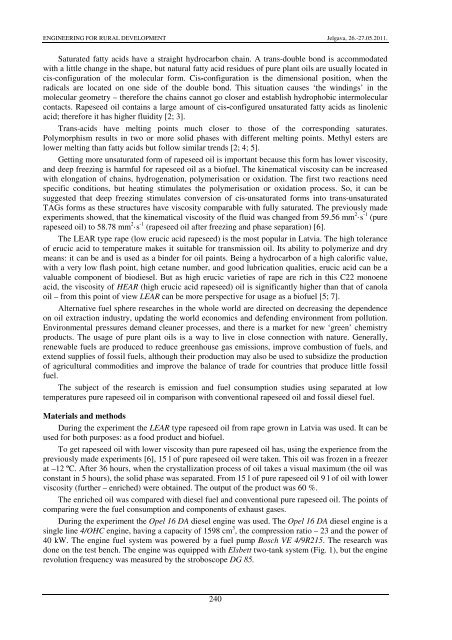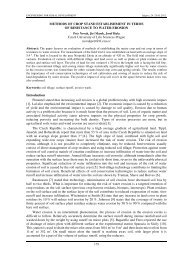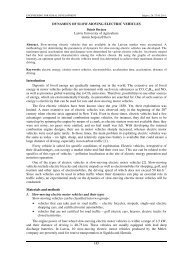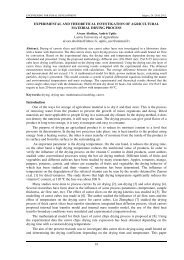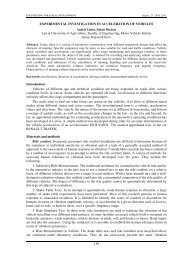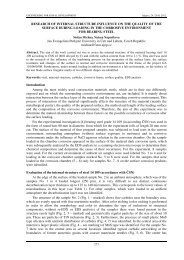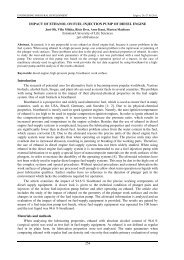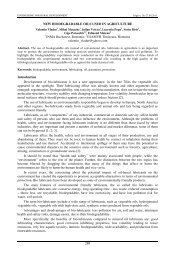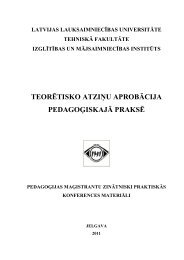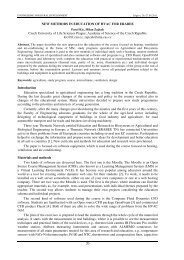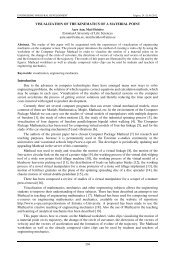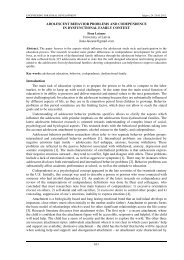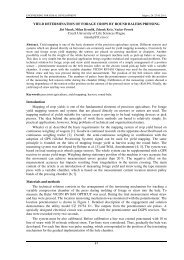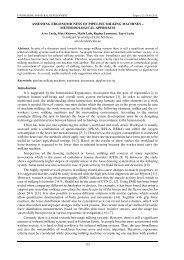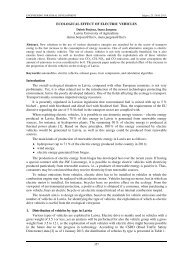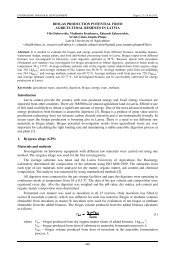Vladimir Baks, Ilmars Dukulis, Aivars Birkavs Latvia University
Vladimir Baks, Ilmars Dukulis, Aivars Birkavs Latvia University
Vladimir Baks, Ilmars Dukulis, Aivars Birkavs Latvia University
You also want an ePaper? Increase the reach of your titles
YUMPU automatically turns print PDFs into web optimized ePapers that Google loves.
ENGINEERING FOR RURAL DEVELOPMENT Jelgava, 26.-27.05.2011.<br />
Saturated fatty acids have a straight hydrocarbon chain. A trans-double bond is accommodated<br />
with a little change in the shape, but natural fatty acid residues of pure plant oils are usually located in<br />
cis-configuration of the molecular form. Cis-configuration is the dimensional position, when the<br />
radicals are located on one side of the double bond. This situation causes ‘the windings’ in the<br />
molecular geometry – therefore the chains cannot go closer and establish hydrophobic intermolecular<br />
contacts. Rapeseed oil contains a large amount of cis-configured unsaturated fatty acids as linolenic<br />
acid; therefore it has higher fluidity [2; 3].<br />
Trans-acids have melting points much closer to those of the corresponding saturates.<br />
Polymorphism results in two or more solid phases with different melting points. Methyl esters are<br />
lower melting than fatty acids but follow similar trends [2; 4; 5].<br />
Getting more unsaturated form of rapeseed oil is important because this form has lower viscosity,<br />
and deep freezing is harmful for rapeseed oil as a biofuel. The kinematical viscosity can be increased<br />
with elongation of chains, hydrogenation, polymerisation or oxidation. The first two reactions need<br />
specific conditions, but heating stimulates the polymerisation or oxidation process. So, it can be<br />
suggested that deep freezing stimulates conversion of cis-unsaturated forms into trans-unsaturated<br />
TAGs forms as these structures have viscosity comparable with fully saturated. The previously made<br />
experiments showed, that the kinematical viscosity of the fluid was changed from 59.56 mm 2 ·s -1 (pure<br />
rapeseed oil) to 58.78 mm 2 ·s -1 (rapeseed oil after freezing and phase separation) [6].<br />
The LEAR type rape (low erucic acid rapeseed) is the most popular in <strong>Latvia</strong>. The high tolerance<br />
of erucic acid to temperature makes it suitable for transmission oil. Its ability to polymerize and dry<br />
means: it can be and is used as a binder for oil paints. Being a hydrocarbon of a high calorific value,<br />
with a very low flash point, high cetane number, and good lubrication qualities, erucic acid can be a<br />
valuable component of biodiesel. But as high erucic varieties of rape are rich in this C22 monoene<br />
acid, the viscosity of HEAR (high erucic acid rapeseed) oil is significantly higher than that of canola<br />
oil – from this point of view LEAR can be more perspective for usage as a biofuel [5; 7].<br />
Alternative fuel sphere researches in the whole world are directed on decreasing the dependence<br />
on oil extraction industry, updating the world economics and defending environment from pollution.<br />
Environmental pressures demand cleaner processes, and there is a market for new ‘green’ chemistry<br />
products. The usage of pure plant oils is a way to live in close connection with nature. Generally,<br />
renewable fuels are produced to reduce greenhouse gas emissions, improve combustion of fuels, and<br />
extend supplies of fossil fuels, although their production may also be used to subsidize the production<br />
of agricultural commodities and improve the balance of trade for countries that produce little fossil<br />
fuel.<br />
The subject of the research is emission and fuel consumption studies using separated at low<br />
temperatures pure rapeseed oil in comparison with conventional rapeseed oil and fossil diesel fuel.<br />
Materials and methods<br />
During the experiment the LEAR type rapeseed oil from rape grown in <strong>Latvia</strong> was used. It can be<br />
used for both purposes: as a food product and biofuel.<br />
To get rapeseed oil with lower viscosity than pure rapeseed oil has, using the experience from the<br />
previously made experiments [6], 15 l of pure rapeseed oil were taken. This oil was frozen in a freezer<br />
at –12 ºC. After 36 hours, when the crystallization process of oil takes a visual maximum (the oil was<br />
constant in 5 hours), the solid phase was separated. From 15 l of pure rapeseed oil 9 l of oil with lower<br />
viscosity (further – enriched) were obtained. The output of the product was 60 %.<br />
The enriched oil was compared with diesel fuel and conventional pure rapeseed oil. The points of<br />
comparing were the fuel consumption and components of exhaust gases.<br />
During the experiment the Opel 16 DA diesel engine was used. The Opel 16 DA diesel engine is a<br />
single line 4/OHC engine, having a capacity of 1598 cm 3 , the compression ratio – 23 and the power of<br />
40 kW. The engine fuel system was powered by a fuel pump Bosch VE 4/9R215. The research was<br />
done on the test bench. The engine was equipped with Elsbett two-tank system (Fig. 1), but the engine<br />
revolution frequency was measured by the stroboscope DG 85.<br />
240


